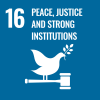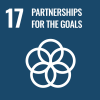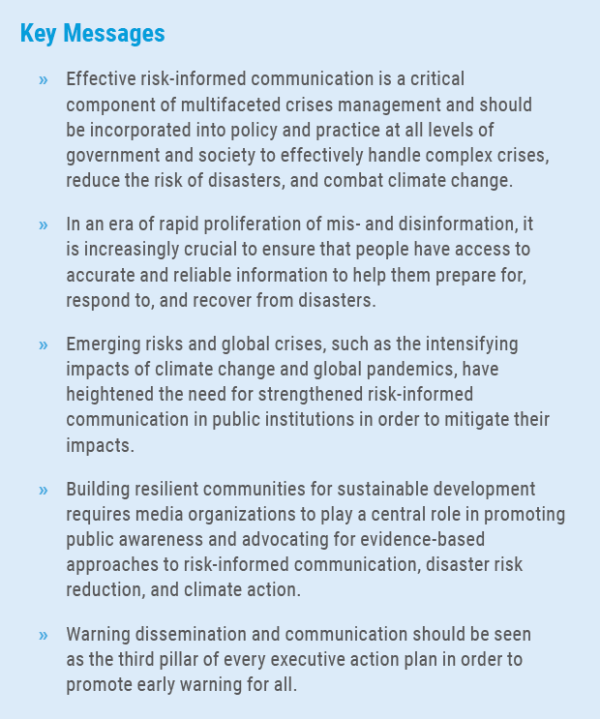
Introduction
Risk-informed governance and a strong risk management framework are essential for ensuring disaster risk reduction (DRR) and resilience in rapidly changing and complex world. Governments and public institutions can use risk-informed strategies for efficient decision-making and policy formulation in a world characterized by emerging challenges such as climate change, economic volatility, food insecurity and global health crises. Risk management is a key strategy to implement the principle of sound policymaking, one of the 11 principles of effective governance for sustainable development. “Effective risk communication along the risk policy cycle is considered highly relevant for successful risk management, from prevention to response, preparation, review and monitoring of diverse risks.”
Risk-informed communication is one of the key dimensions of risk-informed governance that emphasizes the significance of promoting DRR and resilience. It is fundamental to the effective management of crises and plays a critical role in preparing for, responding to, and recovering from disaster situations. In an increasingly interconnected world where mis- and disinformation spread rapidly, ensuring that people have access to accurate and reliable information has become a key challenge. Global crises, such as disasters, conflicts and global pandemics have heightened the need for strengthening risk-informed communication. According to the Global Assessment Report on Disaster Risk Reduction 2022, if current trends continue, the number of disasters per year globally may increase from around 400 in 2015 to 560 per year by 2030 – a projected increase of 40%.
Ineffective risk communication in times of disasters has the potential to spread mis- and disinformation and sensationalism, which has the tendency to generate panic resulting in grave consequences and impact. According to the National Oceanic and Atmospheric Administration (NOAA), effective communication of extreme weather warnings can reduce fatalities by up to 45%. Timely and clear communication of threatening disasters is vital in helping communities prepare and evacuate when necessary. For every $1 invested in early warning systems (EWS), which enhances risk communication, there is a return of $6 in benefits of disaster prevention and reduction in losses. Effective EWS have a higher probability of guiding people to take proactive measures in reducing damage and saving lives. The UN Secretary-General calls for protecting everyone on Earth through universal coverage of EWS by 2017 through the Early Warning for All Initiative.
Ensuring effective communication is central to strengthening resilient communities, and public institutions in charge of information have a critical role to play in promoting public awareness, building trust, ensuring social cohesion and advocating for DRR solutions through constructive and evidence-based reporting systems. In the context of climate action, risk-informed communication is critical for promoting behavioral change, culture of safety, stakeholder engagement, effective coordination and the adoption of sustainable practices. In line with the principles of effective governance for sustainable development, particularly the one on sound policymaking, risk management frameworks in the public sector are essential for effective governance and sustainable development. They “entail the institution and incorporation of effective risk management systems, processes, and strategies into the modus operandi of public institutions and governments. The risk cycle includes crisis management and building back or recovery.”
Purpose and Scope
The ability to initiate, plan, develop, coordinate, and disseminate accurate, timely, and reliable information, alerts, warnings, and notifications to the public and responders in crises situations is central to risk-informed communication. Risk-informed communication should be geared towards enabling the population at risk to make informed decisions to mitigate the effects of disasters and take precautionary measures. It is in this regard that this brief seeks to examine how to strengthen risk-informed communication for addressing multifaceted crises management, DRR, and climate action. Drawing on the current global situation and good practices, it explores the importance of enhancing risk-informed communication. It identifies key challenges for strengthening government institutions that are responsible for effective communication, provides guidance on how to integrate risk-informed communication strategies into disaster management and proposes policy recommendations for policymakers, practitioners, and other stakeholders.
Increasing Recognition of Risk-Informed Governance and Communication for DRR and Climate action
Risk-informed governance and robust risk management frameworks play an indispensable role in advancing the 2030 Agenda for Sustainable Development. It is imperative that governments and decision-makers employ risk-informed approaches to accelerate progress on achieving the 2030 Agenda. The Sendai Framework for Disaster Risk Reduction 2015-2030 emphasizes the need for timely and accurate risk information to enable informed decision-making. It also recognizes that effective communication is essential for raising awareness, understanding, and knowledge of disaster risk. The 2023 Midterm Review of the Sendai Framework for DRR and its Political declaration (A/RES/77/289) calls for strengthen risk awareness and communication at all levels. The Paris Agreement on Climate Change recognizes the significance of public education, awareness, participation, access to information, and international cooperation in promoting climate resilience and adaptation. Similarly, the Intergovernmental Panel on Climate Change (IPCC) emphasizes that effective risk communication and engagement can play a critical role in increasing understanding and responsiveness of climate change risks and opportunities, encouraging appropriate risk management, and fostering social learning and behavior change.
Risk-Informed Communication and the Risk Perception and Communication Model (RPCM)
One key theoretical framework for risk-informed communication is the Risk Perception and Communication Model (RPCM) by Peter M. Sandman. The RPCM provides a comprehensive framework for understanding and analyzing how people perceive and respond to risk communication. The model highlights the importance of factors such as trust, transparency, and empathy in effective risk communication. The most important fact about risk communication is the incredibly low association between a hazard, i.e., how much harm it is likely to cause and its outrage i.e., how upsetting it is likely to make people feel. Thus, one’s knowledge about a dangerous risk tells virtually nothing about whether it is upsetting. Similarly, when it appears upsetting, that also says practically nothing about whether it is dangerous. The focus should be on high-outrage, low-hazard risks, where the key objective of risk communicators is to reduce public concern and panic. Based on this distinction, risk communication is classified into four strands in Table 1 and Figure 1.
Challenges in Ensuring Public Institutions’ Risk-Informed Communication
Notwithstanding the significance of risk-informed communication, there are challenges constraining governments at all levels in spearheading effective risk-informed communication during disasters, and climate change events. The challenges include:
- Mis- and disinformation: An overwhelming stream of mis- and dis-communication in times of crises has the potential to hinder trust in institutional communication and institutions in general. The Code of Conduct for information integrity therefore seeks to provide a concerted response to information threats.
- Inadequate resources: Many governments lack the resources needed, including adequate funds and infrastructure, to implement effective communication strategies.
- Information overload: In times of crises, communities can be inundated with information, making it difficult to identify accurate and reliable information. Information is usually not geographically, or location tailored in times of crises.
- Cultural and linguistic barriers: Effective communication requires paying attention to the sensitivity of cultural and linguistic context because such barriers can impede effective communication.
- Limited access to information: Stakeholders may not always have access to accurate and timely information about crises due to lack of technical capacity.
- Inadequate capacity to interpret information: Even when communities have access to information, they still lack the capacity to interpret, making it difficult to make informed decisions.
- Lack of trust in the source of information: People may not trust the source of information, particularly when it is provided by governments/institutions that have a history of misinformation or manipulation.
- Inadequate policy and legal frameworks: Many countries lack the needed policies and legal frameworks such as on data privacy, access to information, and emergency communication systems.
- Limited institutional coordination: There is a lack of effective and robust collaboration and integration mechanism among institutions across all levels of government in many countries.
Innovative Practices and Solutions for Effective Public Institutions’ Risk-informed Communication for DRR and Climate Action
Several innovative practices and solutions of how risk-informed communication is enhancing the effectiveness of crises management, DRR, and climate action exist. These approaches enhance risk perception, increase engagement, and improve decision-making for resilient communities.
Case 1: FATHOM for Flood Risk Communication in the UK
FATHOM is an innovative geospatial technology that combines flood modeling and science to enhance flood risk communication. The technology incorporates social science data, including demographic and socioeconomic information, to enable stakeholders to understand the impact of flooding on vulnerable communities. The system provides real-time information to take precautions, such as evacuation and flood risk management.
Policy Recommendations on the Strategies to Promote Public Institutions’ Risk-Informed Communication for DRR and Climate Action
The role of governments and public institutions in promoting risk-informed communication for DRR and climate action is pivotal to building resilient and sustainable communities. Governments play a central role in setting up policies, regulations, institutional arrangements, and standards that underpin risk management and climate action. This policy brief proffers some policy recommendations to promote risk-informed communication in this “decade of action” and beyond. These policy recommendations and innovative solutions are significant for addressing the challenges faced by developing countries experiencing severe resource constraints and insufficient technological tools to counter mis- and disinformation.
Ensure institutional coordination at all levels of government: “Robust institutional coordination and integration mechanisms (offline and online), interagency linkages, and collaboration and cooperation frameworks including interoperability backed up by the appropriate digital government and information and communication technology (ICT)” are key to effective risk-informed governance and communication.
Enhance public institutions’ risk-informed communication strategies: Governments should strengthen public institutions to promote transparent, accountable, inclusive and evidence-based communication. Transparency and accountability should be based on scientific data to ensure accuracy and reliability as well as decentralizing communication systems at the local level during crises.
Ensure clear, concise, accurate and timely messaging: Guaranteeing clear and timely messaging is one of the fundamental strategies for risk-informed communication. It involves providing information that is easily understandable, concise, and relevant.
Leverage digital technologies and multi-channel communication: Digital and frontier technologies such as Artificial Intelligence (AI), drones, social media, and geospatial information systems (GIS) can enhance risk communication and EWS by improving speed, accuracy, and accessibility. Mobile phone-based communication and alerts systems provide immense benefits in many developing countries where mobile phone penetration and usage is relatively high compared to internet access.
Case 2: The InaRISK Mobile Application in Indonesia
The InaRISK Mobile Application is an increasingly popular tool for enhancing risk-informed communication. The App is a successful example of how technology can support community based DRR as it provides real-time information on weather conditions, flood risks, earthquakes etc. The App also allows users to report on risks and receive alerts/warnings. The App has improved the accuracy and timeliness of disaster risk information and has increased community participation in DRR.
Tailor communication to the needs of various audiences: Effective communication strategies must customize information to the needs of the anticipated audience to ensure it is understandable, provides actionable steps and resonates with the target population. This should consider the special needs of persons with disabilities (PWDs).
Leverage innovative solutions and tools: Countries can take advantage of innovative solutions and other resources to counter mis- and disinformation in times of crises and health emergencies.
Case 3: WHO Information Network for Epidemics (EPI-WIN)
EPI-WIN is part of WHO’s Health Emergency Programme’s risk communication efforts and was established following the outbreak of COVID-19. It provides resources and regular updates, answering pertinent questions as epidemics unfold aimed at de-bunking myths on social media and other sources and leverage existing networks to disseminate information and fight infodemics.
Integrate gender issues and address cultural and linguistic diversity: Gender issues are critical as people have varying perceptions, experiences, and vulnerabilities to hazards. Addressing cultural and linguistic diversity is a critical strategy for risk-informed communication. Using translators, interpreters, and culturally appropriate messaging is important.
Rely on trustworthy sources: Trustworthy sources are essential for risk reduction and climate action. People are more likely to act when information comes from trustworthy sources. Engaging with experts, community/opinion leaders and influencers is fundamental in building trust and credibility.
Use storytelling and narratives: Storytelling and narratives are effective tools for risk-informed communication as they emotionally engage audiences and enhance understanding of complex issues. Stories and narratives can be used to illustrate the benefits and consequences of DRR mechanisms.
Case 4: The use of Storytelling to Communicate the Impacts of Climate Change
The Climate Storytellers project, developed by UNDP enables communities to share their stories of the impact of climate change on livelihoods. The project raises awareness and promote action on climate change by providing a platform for communities to voice their concerns and engage with decision-makers.
Apply framing: Framing entails the process of influencing how audiences perceive information through words and visuals. Positive framing can be used to highlight the success of response effort in a crisis situation, while negative framing can raise awareness of its severity and consequence.
Promote effective participation, engagement, and partnerships: Participation and multi-stakeholder engagement is essential to the success of risk-informed communication through collaboration with the private sector, civil society, academia, and think-tanks etc.
Case 5: CDC’s Response to the 2014–2016 Ebola Epidemic — West Africa and United States
The 2014–2016 Ebola required a massive international response and partnership to respond to global health emergencies. The Centers for Disease Control and Prevention (CDC) focused on public health measures including through risk communication, contact tracing etc. in addressing rumors and stigma.
Invest in capacity building, monitoring, and evaluation: Capacity building is a decisive component of effective risk-informed communication. Monitoring and evaluation should be an ongoing process that measures effectiveness and impact through feedback and lessons learned.
DESA/UN capacity development support: Member states can take advantage of DESA’s expertise in strengthening capacities through trainings, platforms for knowledge sharing, peer-to-peer learning and good practices, advisory services, policy advocacy and partnership engagements for implementing risk-informed communication strategies.
Mainstream risk-informed communication into public policy and decision-making processes and address ethical issues: Effective risk communication requires integrating climate adaptation strategies, DRR and emergency response plans into policy and decision-making processes at all levels of government. Risk-informed communication should address concerns and ethical issues on privacy, data governance and protection.
 Welcome to the United Nations
Welcome to the United Nations



